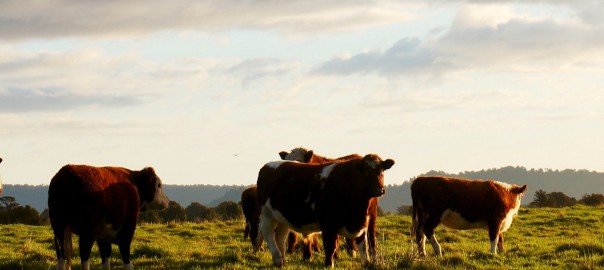Here at ButcherBox, we are proud to be able to deliver nutrient-rich, thoughtfully-sourced grass-fed beef to our subscribers’ doors each month.
We get many questions about what the differences between grass-fed and organic, and, for that matter, why grass-fed is better than supermarket meat. It comes down to a few critical issues: Feed, certification, and, at least for us, treatment.
Grass-fed beef
We’ve written about grass-fed beef on numerous occasions. Our passion for healthy grass-fed meat is the reason why we started ButcherBox.
Grass-fed beef is, by definition, meat from cattle that have grazed on grass — and sometimes forage — in their lives. This is in opposition to grain feeding, which has long been the standard of the beef industry and is most likely what you buy from the grocery store or butcher.
Because a grain-fed cow eats grains as its primary source of food, its meat does not have the same nutrition profile as meat from a cow that has eaten grass its entire life. For instance, grass-fed beef has a better omega-6 to omega-3 ratio, as well as more good fatty acids, nutrients, and minerals than grain-fed beef.
Also, grain-feeding occurs on feedlots, which we are vehemently opposed to. Grain-feeding in feedlots — where cattle are crammed into pens together — is done to make cows fatter to bring to market more significant quantities of beef that have marbling that the American consumer has unfortunately become used to over the past century.
Because of the horrible conditions at feedlots, which breed disease and the desire to raise bigger cows faster (i.e., get more meat on the market more quickly, regardless of quality), grain-fed cattle often receive antibiotics and hormones as well.
Thoughtfully-sourced meat is not just healthier, it’s more humane: No pens, no feedlots, no hormones, and no antibiotics.Pasture-raised cattle graze on grass as nature intended.
This brings us to one of our most significant concerns when it comes to grass-fed meat: Purposely deceitful labeling of some meat products.
Grass-finished is the key
The term grass-fed is used so often, that it is assumed that all “grass-fed” beef is the same: Meat from cows that have spent their lives grazing on lush grass green fields.
However, some meat producers purposely trick consumers into buying grass-fed beef when they are actually buying grass-fed, grain-finished meat. We’ve discussed this on Roam before, but here’s the Cliff’s Notes version: Almost all cattle spend the first year of their lives grazing with their mothers and eating grass. Industrial farms then move these cattle to inhumane feedlots. Unfortunately, some producers use this as justification to label their beef as “grass-fed, grain-finished,” just because the cows ate grass for a short period.
Additionally, some beef industry operators do feed their cows grass, hay, or forage for the majority of their lives. But they also feed the cows grains to fatten them up, labeling their meat “grass-fed, grain-finished” as well.
When consumers buy grass-fed beef, they are expecting meat that is more nutritious than grain-fed or corn-fed beef. Grass-fed, grass-finished has more good omega-3 fatty acids, more conjugated linoleic acids, and other vital nutrients.
More than anything, being pasture-raised — truly grass-fed — is good for the cow (a cow’s digestive system evolved to eat grass, not grain or corn).
So what is organic beef?
Organic beef is meat that is sourced in a specific way so that the USDA designates it as “certified organic.”
According to the Department of Agriculture’s website, to meet the standards of the “certified organic” label, a cow needs to be raised, “in living conditions accommodating their natural behaviors (like the ability to graze on pasture), fed 100% organic feed and forage, and not administered antibiotics or hormones.”
Now the problem is that this means there are no qualifications on what that organic feed can be. This is the most prominent difference between grass-fed, grass-finished and organic beef.
A filet mignon or New York strip steak you buy that is organic may be from an animal that has eaten corn or grain its entire life, not grass-fed cows.
A grass-fed New York strip that comes from pasture-raised, grass-fed cattle has more health benefits — good fatty acids, nutrients, and the better omega 6 to omega-3 ratio — and, to our mind, tastes better. But, it may or may not be organic grass-fed beef.
The important distinction is that most grass-fed beef is raised organically, but organic beef is not necessarily grass-fed. Not all farmers receive the organic certification label from the USDA, either because the process is too cumbersome or they use some non-organic product on a section of their land, so they don’t have “organic pastures” to meet the standard for a certified organic label.
I know this is confusing.
From our perspective, the “organic” label is not as important as whether or not a cow is grass-fed and grass-finished, is raised humanely, and has never been given hormones or antibiotics. Period.
To ensure this, we vet our farmers carefully before we partner with them, and stay in close communication with them, to make sure they meet our high standards.
Our close relationship with our farmers — many of whom run small independent or family farms — allows us to bring the highest-quality beef products to our members each month.




